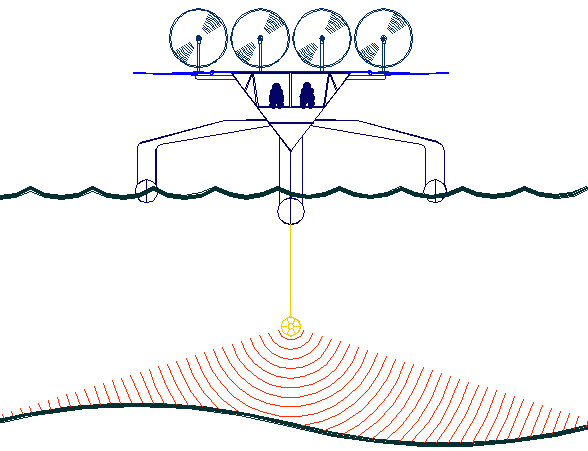|
Introduction: background of the invitation to tender
Sense and avoid is obviously a critical capability to all UMS (Unmanned Maritime Systems).
They need to achieve an adequate and continuous awareness of other water users or
obstacles in their vicinity. The situation needs to be either evaluated on board or transferred
to an operator in the case of remotely operated UMS and analysed on board for
(semi) autonomous UMS.
The result of the study is important since the maritime community may need to convince
stakeholders that unmanned maritime systems operations with nobody on board are
possible. There may be a need to demonstrate to IMO or other organizations that
situation awareness capability is sufficient and ideally almost independent on environment
conditions.
The outcome will have a significant impact on European collaborative initiatives with
Maritime Mines
Counter Measures being a first possible example. It should contribute to the
interoperability of different European systems. It could also pave the way for the
achievement of a common understanding on a future European family of SA systems for
UMS.
Last but not least, the result is expected to contribute to the Best Practice Guide for
Unmanned Maritime Systems Handling, Operations, Design and Regulations being
developed by the SARUMS group.
Description of the subject and scope of the contract
The aim of this study will be to provide the EU Maritime community with a rigorous informed
view of SA system and their potential to ensure safe UMS operations. The study shall
attempt to present an overview of the relevant technologies, group and assess them in
accordance with a Sense and Avoid Policy defining a the safety level for
UMS, type of technology, sensors or usage for the benefit of future standardization as well as to take into
account needs for different types of UMS.
Sense and avoid may be viewed as being part of situation awareness. Situation awareness
is the perception of environmental elements with respect to time and/or space, the
comprehension of their meaning, and the projection of their status after some variable has
changed, such as time Situation awareness involves being aware of what is happening in the vicinity to understand
how information, events, and one's own actions will impact goals and objectives, both
immediately and in the near future. Lack of, or inadequate situation awareness is obviously
an issue for UMS. A situation awareness system also includes the means to be able to
decide on how to act, normally to achieve a safe state. Avoid may be a typical action, but
several other options could exist.
It is understood that situation awareness may also be derived as part of a broad capability
that extends into sophisticated mission and task specific operational needs, such as the
ability to classify objects as threat or friendly. However, for the scope of this study the
awareness shall be focused primarily on sense and avoid function understood as systems to
satisfy safety and navigational needs.
Situational awareness is often illustrated as part of the OODA loop which includes the
sequential event loop of Observe – Orient – Decide – Act. The focus of this study shall be
around systems capable of Observe-Orient-Decide. The Act, to act, is important enough but
whatever action is needed would be taken care of by other functions and systems outside of
the scope of this study. Orient-Decide is of particular importance for the higher autonomy
control level systems (autonomous control). An operator is assumed to be capable to cover
Orient-Decide for lower control levels (remote control).
A capable UMS Sense and Avoid system should fulfil the following:
• Observe: Detect objects within a required awareness zone with no limitations due sea
state or reduced visibility. Separate objects of different size. Determine if objects are
stationary or moving. USV needs to cover water surface as well as underwater to some
extent. UUV needs to cover the water volume. COLREG requires both seeing and
hearing.
• Orient: Capability to conduct a proper analysis of the situation. Analysis to determine if
there is a risk for collision. Capability to present options on how to act.
• Decide: Capability to take optimum decision for the current situation.
Unmanned Air Vehicles (UAV) may also be part of UMS, but for the purpose of this study
UMS shall be limited to include Unmanned Surface Vehicles (USV) and Unmanned
Underwater Vehicles (UUV).
LINKS
http://www.eda.europa.eu/procurement-gateway/opportunites/eda-procurement/procurement-view/13.r-t.op.624
http://www.defense-unmanned.com/article/1022/asv-wins-contract-for-unmanned-boat.html
http://rpdefense.over-blog.com/tag/LEMUSV/
http://www.science.mod.uk/Engagement/the_portal.aspx http://www.science.mod.uk/Engagement/enterprise.aspx https://www.dstl.gov.uk/centrefordefenceenterprise https://www.dstl.gov.uk
UKHO
http://www.maritimejournal.com/news101/industry-news/ukho-appoints-new-national-hydrographer http://en.wikipedia.org/wiki/United_Kingdom_Hydrographic_Office http://www.ths.org.uk http://www.spri.cam.ac.uk/friends/committee/ http://www.thefutureofnavigation.com/ten_steps.aspx http://www.quaynote.com/ankiti/www/?code=ecdis13&f=programme
Wiki
United_Kingdom_Hydrographic_Office
https://www.dstl.gov.uk/insight
US
Department of Navy Research, development & Acquisition - http://acquisition.navy.mil/ US
Fleet Forces Command - http://www.cffc.navy.mil/
US
http://www.msc.navy.mil/
http://en.wikipedia.org/wiki/Naval_Oceanographic_Office

The Bluefish SNAV
platform, presently under development, is a robotic ocean workhorse. Based on a stable
SWASH
hull that can achieve high speeds for long duration. This robot
ship uses no diesel fuel to monitor the oceans autonomously (COLREGS
compliant) at 6-7 knots continuously 24/7 and 365 days a year - only possible with the revolutionary (patent) energy harvesting system.
The vessel may also sprint from one location to another covering
distances in excess of 100 nautical mile at speeds of over 10 knots -
Thus may reach a target area within a relatively short response time. The
hullform is ideal for automatic release and recovery of ROVs
or towed arrays, alternating between drone and fully autonomous modes.
International development partners and agents are welcome. Initial
results suggest that this vessel
pays for itself in fuel saved every ten years.
|
